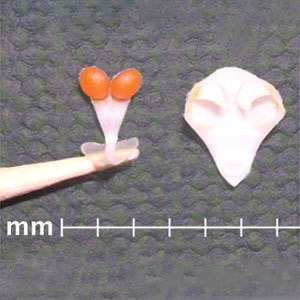Plants can be multiplied mainly by two methods. One is the sexual method and the other is the vegetative method. In the former method, generally two different parents plants are involved, leading to seed formation; eventually seed germination takes place. The second is the vegetative method in which different parts of the single parent are used to produce new plants. Seed germination in orchids occurs only in association with a special type of fungus. Further, seed grown orchids take very long to mature and bloom, sometimes as long as seven to eight years.
Contrary to this, orchids can be quite easily propagated vegetatively. The success rate of vegetative propagation is much higher and the new orchid starts to bloom early. The maturity of a vegetatively grown orchid is decided by the maturity stage of the parent plant.
There are different ways of vegetative propagation. In case of orchids like the Bulbophyllums or the Dendrobes, each stem possess roots. You can separate these from the parent plant and plant them as a new plant. But take care that the stem bears sufficient leaves for food preparation.
Orchids can be grown through cuttings taken from mature plants. Sometimes orchids produce aerial roots along the exposed stem at the nodal region. These stem portions (bearing roots) when separated (hygienically!), can easily grow as a separate individual.
Using backbulbs is another way to divide orchids having bulbs. What do you understand by backbulbs? These are actually the previous growing season’s bulbs. When the flowering season passes, the stem shrinks and eventually falls off leaving behind the bulb. These bulbs bear very tiny shoot buds hidden under the nodal scales, from which new offshoots grow out in the next season. After the stem falls off the bulbs enter resting phase. So these can be stored in sand with occasional watering, taking care that rotting does not set in. Once the next growing season starts, plant the bulbs in the appropriate growing medium. New growth will soon be seen sprouting out. I once multiplied Eria by placing the backbulbs on coconut fibres, inside polythene bags. After blowing air into them, I closed the top of the bags with thread. Exchange of gases was facilitated through tiny punched holes.
Sometimes tiny plantlets can be seen sprouting out at the base of orchids, these are referred to as kiekies. These kiekies can be carefully separated from the parent orchid and planted in a new pot/basket; taking care that the kiekies are sufficiently grown.
The above mentioned methods of multiplication require very little extra cost, if any. There are methods of propagation, however, which are costlier. These include various tissue culture techniques by which we can produce new plants, using different vegetative parts like stem, leaves etc. Mericlones are also produced through tissue culture. Another technique of propagation through tissue culture is generation of artificial seed capsules.
Disadvantage of the vegetatively multiplied orchids is that these are more susceptible to disease attacks as a group. So if any one of the cloned orchid gets infected, it can very quickly pass the infection to others of its kind. Remove it immediately.
Both methods of propagation have advantages as well as disadvantages; depending upon your resources, you have to decide which method to follow.

Methods of Orchid Multiplication
Propagationby Anu Dharmani
Originally published in BellaOnline
Posted by Sys Admin almost 9 years ago.Article Blog Article Index
Share on Social Media:
New Topics
- David George asked question Odom's Fascination - an unusual orchid in category General Discussion
- Carol Holdren asked question Grow Tent in the Garage in category General Discussion
- David George asked question rlc Caotan Beauty found at Home Depot in category Cattleya Alliance
- Kristin Dorris asked question Odontocidium Orchid fungus? in category General Discussion
- Maria Fernandez asked question Wild. Lisa Devos in category Dendrobiums
New Comments
- Carol Holdren commented on topic "Odom's Fascination - an unusual orchid" by David George
- Dr. Florian Wolf commented on topic "Wild. Lisa Devos" by Maria Fernandez
- Michael Valcarcel commented on member plant Rlc. Chief Takanaka by Walceli Muniz Valverde
- Michael Valcarcel commented on member plant Rlc. Montana Spirit by Michael Valcarcel
- Michael Valcarcel commented on member plant Ctt. Blazing Sun by Michael Valcarcel
- Michael Valcarcel commented on member plant Bc. Spotted Clown by Michael Valcarcel
- Maria Skrypnyk commented on member plant Yamadara Redland Sunset by Maria Skrypnyk
- André Pessina commented on topic "Odontocidium Orchid fungus?" by Kristin Dorris
- Linda Hartman commented on topic "Image of a plant please" by Leshya Perkins
- Paul Reavis commented on orchid Milt. Kismet
- Christiaan Viljoen commented on member plant Psh. fragrans by Christiaan Viljoen
- Christiaan Viljoen commented on member plant Z. maculatum by Christiaan Viljoen
- Christiaan Viljoen commented on member plant C. Gaskell-Pumila 'Azure Star' by Christiaan Viljoen
- Robert H. Findlay commented on member plant Rlc. Joy Sokabe var. Volcano Queen by Sally K
- James Lunsford commented on member plant Lc. Sagarik Wax 'African Beauty AMO/AOS x Blc. Cherry Suisse'Kauai' HCC/AOS var. Cattlyea 'Hybrid ' by James Lunsford
- John Varigos commented on orchid Bulb. schwarzii
- Linda Hartman commented on topic "Issue with Blc. Ben O'Neil "Jubilee" by Glenda Ratliff
- Henry Shaw commented on member plant Ons. Catatante 'Los Roble' by Henry Shaw
- Mary Lane commented on member plant Den. Tianmu Canary by Terre Moore
- Pamela Stegmaier commented on member plant Rlc. Esther Costa var. Orange Fantasy by Mary Lane